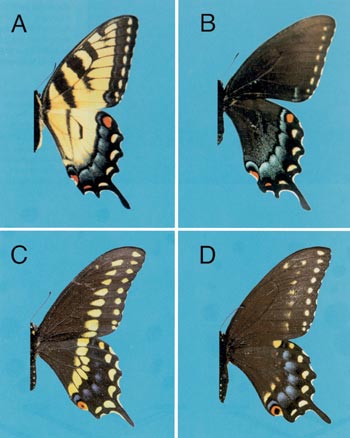
This Article From Issue
November-December 2003
Volume 91, Number 6
DOI: 10.1511/2003.38.0
Butterflies: Ecology and Evolution Taking Flight. Carol L. Boggs, Ward B. Watt and Paul R. Ehrlich (editors). xvii + 739 pp. University of Chicago Press, 2003. Cloth $110; paper $45.
The study of butterflies has long inspired amateur naturalists, and these popular insects have also helped professional ecologists and evolutionists to convey an understanding of their specialized interests to the general public. There are a number of reasons for this: Butterflies are a joy to find, to identify, to watch and to read about.

From Butterflies: Ecology and Evolution Taking Flight.
Why is that? Physical appearance, for one thing: The gaudy ones are gorgeous, and even the drab ones are elegant. What is more, they often react to obvious visual cues, which we can readily perceive and tentatively interpret. And we can see in their behavior similarities to our own: Across species it ranges from sedentary to dispersive, from exploratory to cautious and from aggregative to exclusive. Butterflies depend on resources and habitats that we can easily characterize. They are relatively easy to census. They show variations in abundance from place to place, which may suggest the geography of their evolution. And changes in their numbers over time are powerful indicators of changes in their, and our, environment.
Butterflies have some characteristics that are more accessible to the professional scientist than the amateur: They have a complex development with seemingly magical changes; they interact with one another and with food plants through specialized chemical senses and chemical metabolism; and they can be genetically "fingerprinted" for forensic disclosure of the histories of their populations.
Butterflies: Ecology and Evolution Taking Flight gives examples of all of this and more. The book grew out of papers and posters presented at the Third International Symposium on Butterfly Ecology and Evolution in Crested Butte, Colorado, in 1998. All 26 of the book's chapters are superb. But I should admit that perhaps I'm not the most unbiased judge: Among the 48 contributors are 6 friends of mine, 9 acquaintances and 11 personal heroes.
Space doesn't permit me to comment on every article, so I have decided to highlight those parts that might be of most interest to someone who has a background in science and an amateur's love of butterflies. (Those with a serious professional interest will likely already own the book.) For example, in the section on behavior, chapters by Ronald L. Rutowski and Adriana D. Briscoe describe the structure and physiology of the butterfly eye and go a long way toward explaining how butterflies can perceive so much detail in a cross-stitched mosaic image of their environment. Christer Wiklund describes mate-finding and courtship strategies that rival in range those found in vertebrates, and Erika I. Deinert expands on a mating system that borders on pedophilia.
Several chapters on ecology will help readers to understand the responses of butterflies to the environmental havoc wrought by humans. Jane K. Hill and associates explore ways to predict changes in the geographical ranges of European butterflies and to test those predictions against the observations of dedicated amateurs. Nusha Keyghobadi and coworkers find that habitat fragmentation affects the movement of adults, which can be documented either by observing the distribution of genetic fingerprints or by painting tiny numbers on individual butterflies and finding them again after dispersal.
Those who simply appreciate the extraordinary beauty of butterflies will love the chapters on the genetics, development and evolution of patterns on wings. Paul M. Brakefield and Antónia Monteiro examine the evolution of eyespots (markings that resemble eyes), which may help butterflies startle predators and escape from them. Richard ffrench-Constant and P. Bernhard Koch document the molecular mechanism responsible for dark forms of swallowtail butterflies, which mimic unpalatable unrelated species. And Lawrence E. Gilbert explores the potential for relatively simple genetic mechanisms to generate the outrageously diverse "toolbox" of wing patterns available for mimetic selection in some tropical butterflies. These studies of patterns are dramatized with small but spectacular color illustrations.
Even some of the papers in the section on classification and systematics, topics usually of interest only to specialists, have broad appeal. For example, Dana L. Campbell and Naomi E. Pierce use genetic evidence to develop family trees of symbiotic ant and butterfly species. The ants shepherd and protect the caterpillars of these butterflies from predators. The caterpillars pay for their keep by providing nutritive excretions from specially evolved glands. By comparing the family trees of the ants and butterflies, Campbell and Pierce can argue convincingly that this unusual and highly specialized relationship has evolved several times. At a more general level, Richard I. Vane-Wright shows how seemingly arcane questions about which butterfly species get classified with which others are crucial to setting broad priorities for conservation. In the section on conservation and biodiversity, Camille Parmesan uses maps of geographic ranges (compiled largely from amateur observations) to evaluate butterflies as bioindicators of the effects of climate change.
These are just some of the stories that I think will lure general readers into the rest of the book. In a final synthesizing chapter, two of the editors of the volume, Ward B. Watt and Carol L. Boggs, summarize the symposium that spawned this volume as a demonstration that butterflies are, and will continue to be, model systems for the study of ecology and evolution.—Henry S. Horn, Ecology and Evolutionary Biology, Princeton University
American Scientist Comments and Discussion
To discuss our articles or comment on them, please share them and tag American Scientist on social media platforms. Here are links to our profiles on Twitter, Facebook, and LinkedIn.
If we re-share your post, we will moderate comments/discussion following our comments policy.